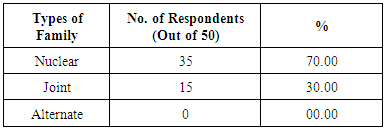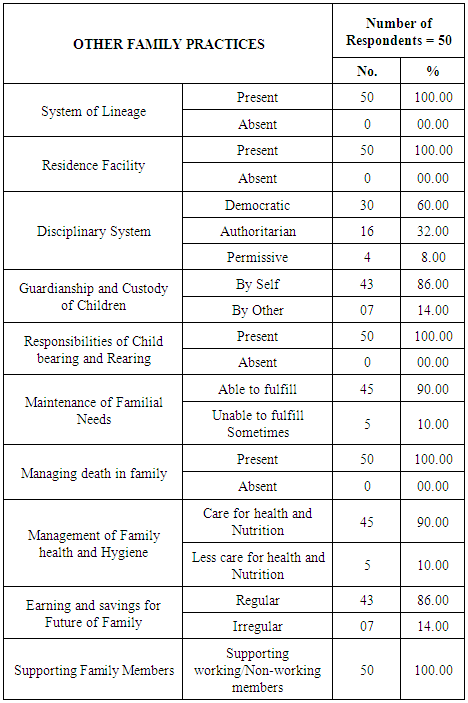-
Paper Information
- Paper Submission
-
Journal Information
- About This Journal
- Editorial Board
- Current Issue
- Archive
- Author Guidelines
- Contact Us
American Journal of Sociological Research
p-ISSN: 2166-5443 e-ISSN: 2166-5451
2017; 7(2): 67-71
doi:10.5923/j.sociology.20170702.01

Changing Family Composition, Structure and Practices in Bhota Town of District Hamirpur, Himachal Pradesh (India): A Comparative Study
Amarjit Lal
Govt. Degree College Hamirpur, HP, India
Correspondence to: Amarjit Lal, Govt. Degree College Hamirpur, HP, India.
| Email: |  |
Copyright © 2017 Scientific & Academic Publishing. All Rights Reserved.
This work is licensed under the Creative Commons Attribution International License (CC BY).
http://creativecommons.org/licenses/by/4.0/

The family, as a primary social institution in India has been undergoing change, both in its composition and structure. The family, as in many societies has been not only the center of socio-economic life, but also the primary source of social security and support for the members of the family. The increasing urbanization, commercialization of the economy and the development of the infrastructure of the modern state have brought changes in the composition and structure of Indian family in the 20th century. The last few decades have brought speedy and important changes in family relations. India's fertility rate has fallen and life expectancy has increased. All of these changes are taking place in the context of increased urbanization and high standard of living, which is separating children from elders and contributing and bringing change in the composition and structure of family-based support system. The Present study is conducted in Bhota Town of District Hamirpur, Himachal Pradesh, India. This paper examines the impact of various contributing factors which bring changes in the composition, structure and practices in Indian family. If this trend continues then it will lead the disintegration in familial relations and adversely affect the caring attitude of the family towards its members.
Keywords: Familial relations, Composition, Structure, Marriage patterns, Practices
Cite this paper: Amarjit Lal, Changing Family Composition, Structure and Practices in Bhota Town of District Hamirpur, Himachal Pradesh (India): A Comparative Study, American Journal of Sociological Research, Vol. 7 No. 2, 2017, pp. 67-71. doi: 10.5923/j.sociology.20170702.01.
1. Introduction
- The family is an important and the primary institution of Indian traditional as well as modern societal set up. In the dynamic nature of society, the complexity of the institution is growing day by day. For the last many years, numbers of studies were conducted to explore the complexity of this very important institution. The family is the essential agency of socialization to learn the basics of cultural life in India. The patrilineal family and extended kinship relationships are the basic units of society in the majority of countries in the world. In Indian joint family, members of three or four generation are living together under one roof, sharing common property, kitchen, worshiping and working together in socio - economic activities. Family patterns are conceptualized in terms of family composition. A household is one of the dimensions of the family pattern. It is a residential and domestic unit composed of two or more persons living under the same roof and eating food cooked in a single kitchen. The family as a primary unit is continuously remained to be one of the most important elements in the fabric of Indian society. Family is the valuable unit of institutional structure of Indian society which exercises the ascribed authority on every member of the family. Familial bond ties an individual to his family and influenced his personality to a great extent. Indian family is the key factor behind the stability and continuity of our culture and society. In these days, changes are taking place rapidly in socio - economic, political and cultural sphere of society showing direct impact on the structure of Indian family. The change in the modes of production changes the patterns of distribution and consumption, considerably. The processes of industrialization, urbanization, commercialization and globalization have shown great impacts on the family. Continuous migration of people from rural to urban areas is a major contributing factor in the growth of slums. Technological advancement brings changes in our traditional hereditary and caste based occupations to new patterns of multiple employment based on specialization and experience. The survival becomes more difficult in these days due to price rise and cut-throat competition in every area of life leads disintegration of family relations. In nutshell these changes in the socio-economic, political and cultural environment of our society have enforced changes in the composition, structures, authority, roles, relationships and values system of our family.Family as a primary social institution is the major agency of socialization which imparts and cultivates social values among individuals. Fundamentally, family is the main source of social values. It is impossible to think of patriotism and nationalism without the presence of family. The family goes on teaching the social values and transforming cultural traits from one generation to another. Family plays a vital role in transforming a biological being to social being. It makes a man capable to deal with societal responsibilities successfully and fulfill the expectations of family and society. It is the need of the hour to strengthen familial relations. It teaches us to show respect to others by creating an environment of mutual understanding, tolerance and patience, love and affection, dedication and devotion and more importantly care and sacrifice towards humanity. It imposes checks on selfishness and restrains rigidity. The survival of traditional culture in Asian societies for a thousand years is due to the continuous emphasis on enforcement of family values. Failure in family system will collapse the whole social system. In the contemporary society emergence of modernization and urbanization, the younger generation is moving away from the joint family system. Modern societies are producing multiple variations in family. Most traditional and extended families with strict gender based sex roles are changing into equal authority based sex roles with more freedom to live-in-relationship. The alternate family pattern is originated due to temporary relationships leading to bad socio-economic conditions. Socio-economic and personal circumstances create variation in the Indian family system. Increasing craze towards Live-in relationship and opting to remain childless voluntarily, promotes small family. Single parent families, female headed households, childless families, adoptive families are some of the commonly observed family variation in India. No study was conducted on changing family composition, structure and practices in this area so far. Thus this study is an attempt to review the impact of various contributing factors which bring change in family composition, structure and practices in urban areas of Bhota in Himachal Pradesh (India).
2. Objectives
- To review the changing family composition in urban areas with respect to following: • Changing role, power and status in family • Changes in familial relationships To review the changing family practices in urban area of Bhota Town with respect to following: • Changing marriage patterns and • Changing other family practices
3. Method
- This study was conducted in Bhota Town of district Hamirpur, Himachal Pradesh, India. For the purpose of the study, fifty families of the same income group residing in this area were selected using Purposive sampling. To collect the data, a survey was conducted by using a self- structured questionnaire with close ended questions. The data were analyzed in terms of mean, frequency and percentage.Himachal at glance:Himachal Pradesh is also known as ‘Dev Bhoomi’ came into existence as a distinct entity on 15 April 1948 with the merger of 30 erstwhile Punjab hilly states. The span of 63 years has taken big strides in the path of social-economic development. The population of Himachal Pradesh is 68, 56,509 in which 34, 73,892 males and 33, 82,617 are female’s. Himachal comes second in literacy rate with 83.78% after Kerala in India. Hamirpur District is situated between 76° 18' to 76° 44’ East longitudes and 31° 25' to 31° 52' North latitude. The tract is hilly covered by Shivalik range. This district was made in 1972 by carving it out from the Kangra district. It is well connected by roads from all sides. Majority of the population here comprise of Hindus. Bulk of the people speaks Pahari. Hamirpur is the most Literate district in Himachal Pradesh. The majority of its population fluently speaks Hindi.
4. Results and Discussion
- The data in table 1 revels that 70% families were nuclear whereas only 30% were joint. There were no families of alternate family type out of selected families. Banerjee (2010) explains that in Indian cities; families aspire to an improved lifestyle, which they recognize is possible with fewer children. Reflecting the rise of the nuclear family in urban India, these households are small in size. According to Kashayap (2004), industrialization, together with technological development, has brought several new challenges to the family. It has brought significant changes to the structure of urban families that have moved from large extended family systems to more nuclear structures.
|
|
|
|
|
5. Conclusions
- From the above paper and other research review we have reached at a conclusion that the majority of the families belonging to middle socio economic status have brought very basic and important changes in the composition and structure of the family. These changes can be viewed in the form of status, role, power, relationships, family practices and marriage patterns. Continuous urbanization of families is changing the structure, composition and practices of family. But family rituals are still being followed by young and old in the families, supporting all working as well as non-working members. Even in modern society some of the traditional family practices are still untouched and having a major role to play in family matters. Traditional marriage rituals and practices like financial exchange during marriage are very commonly practiced in the family. Our results reinforce the view that efforts are needed to protect our traditional value system, joint family and other healthy family practices to maintain the family structure and composition for the betterment of society.
 Abstract
Abstract Reference
Reference Full-Text PDF
Full-Text PDF Full-text HTML
Full-text HTML



